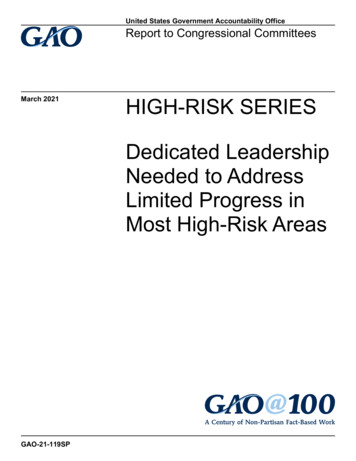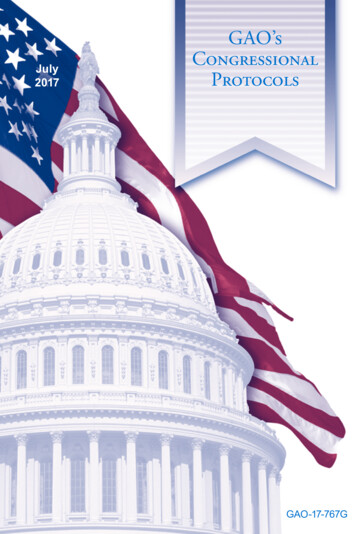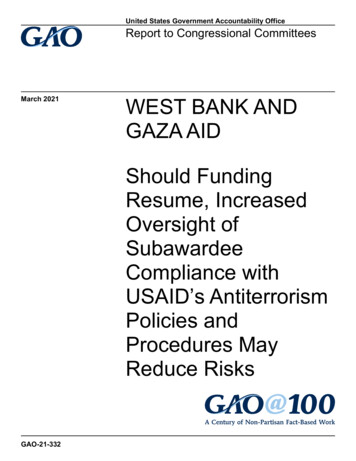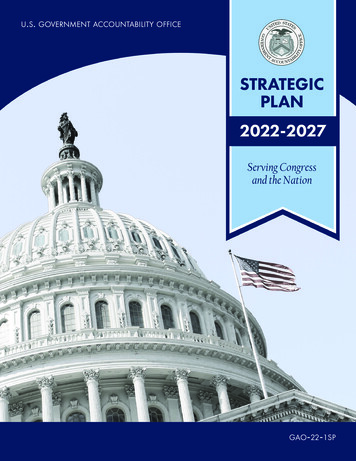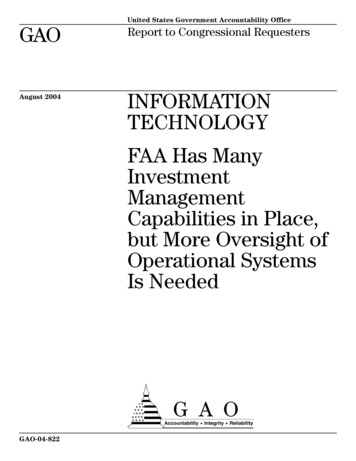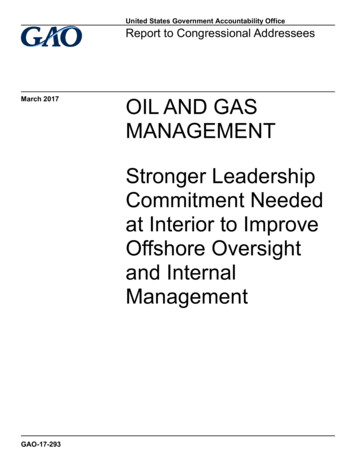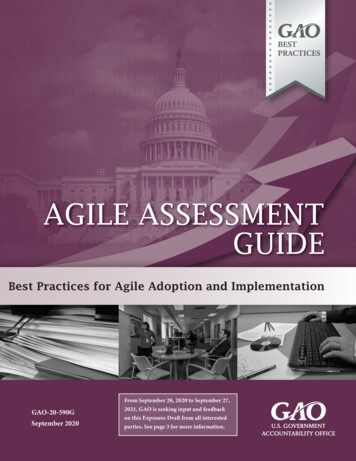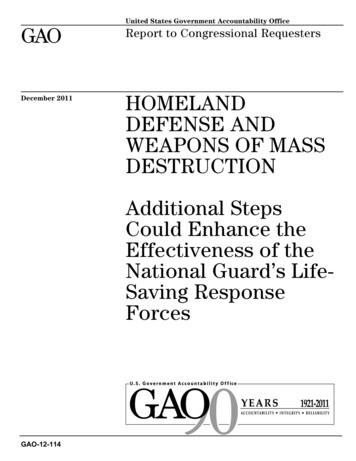
Transcription
United States Government Accountability OfficeReport to Congressional CommitteesDecember 2021INFORMATIONTECHNOLOGYDigital ServicePrograms Need toConsistentlyCoordinate onDeveloping Guidancefor AgenciesGAO-22-104492
December 2021INFORMATION TECHNOLOGY:Digital Service Programs Need to ConsistentlyCoordinate on Developing Guidance for AgenciesHighlights of GAO-22-104492, a report tocongressional committeesWhy GAO Did This StudyWhat GAO FoundFederal agencies spend more than 100 billion annually on IT to improvemission delivery and support; andenhance infrastructure, security, andmanagement. However, because oflongstanding challenges, the federalgovernment’s management of ITacquisitions and operations has beenon GAO’s high-risk list since 2015.For fiscal year 2021, 26 federal agencies reported 7,806 information technology(IT) investments on the federal IT Dashboard, a public website the Office ofManagement and Budget (OMB) launched in 2009. OMB requires agencies toreport their IT investments on the dashboard and categorize them in variousways that help describe their purpose. For fiscal year 2021, agencies reportedtheir investments in one of three portfolio categories: IT infrastructure, security,and management (45 percent); mission delivery (37 percent); and missionsupport services (18 percent). Additionally, agencies are to classify each of theirinvestments under one of 225 different service categories. The two servicecategories with the highest planned fiscal year 2021 spending were ITinfrastructure ( 17.9 billion) and health care delivery services ( 3.9 billion).The Modernizing GovernmentTechnology Act of 2017 included aprovision for GAO to review federal ITprograms and entities, including USDSand 18F, and the extent to which theyduplicate work.This report (1) describes investmentsidentified on the federal IT Dashboard,(2) summarizes prior GAOrecommendations and currentimplementation status on IT duplicationand management roles andresponsibilities, and (3) evaluatesUSDS’s and 18F’s efforts to coordinateIT services to avoid overlap andduplication.To do so, GAO (1) examined IT datareported by 26 agencies on the federalIT Dashboard; (2) identified prior GAOreports that evaluated duplicative ITand IT roles and responsibilities, anddetermined the number andimplementation status of relevantrecommendations; and (3) comparedUSDS and 18F coordination activitieswith leading collaboration practicesidentified in GAO’s prior work.What GAO RecommendsGAO is making two recommendations,one each to OMB and GSA, toestablish and document an approachto coordinate on IT guidance providedto agencies. OMB and GSA generallyconcurred with the recommendations.Over the past 10 years, GAO has issued 12 reports that included 275recommendations to agencies to address issues related to duplicative IT, suchas weaknesses in the processes agencies used to reduce contract duplication.GAO also made 117 recommendations in six reports to address issues related toIT management roles and responsibilities, such as unclear responsibilities forchief information officers and acquisition officials. As of October 2021, agencieshad implemented a total of 290 (74 percent) of the recommendations.Implementing the remaining 102 would provide agencies greater assurance thatthey are effectively managing IT acquisitions and operations.Status of GAO Recommendations Related to Duplicative Information Technology (IT) and ITManagement Roles and Responsibilities, as of October 2021Number of relatedNumber fullyNumber not ive IT275238 (87 percent)37 (13 percent)Roles and responsibilities11752 (44 percent)65 (56 percent)Total392290102Source: GAO analysis of GAO reports. GAO-22-104492OMB’s U.S. Digital Service (USDS) and the General Services Administration’s18F program offices help agencies deliver digital services, such as public facingwebsites and on-line benefit applications. These offices conduct similar activitiesto fulfill their missions, such as providing IT expertise on agencies’ projects,recruiting IT experts, and developing guidance to assist agencies. AlthoughUSDS and 18F coordinated on projects and recruiting efforts, they did not alwaysdo so to avoid developing duplicative IT guidance. Specifically, neither entity hadan established, documented coordination approach, even though they hadissued guidance on the same IT acquisition and development topics with similarcontent. USDS and 18F officials acknowledged the need to improve guidancecoordination, but did not have specific plans to do so. Documenting acoordinated approach for developing and issuing guidance would reduce the riskof overlap and duplication, and the potential for conflicting information.View GAO-22-104492. For more information,contact Carol C. Harris at (202) 512-4456 orharriscc@gao.gov.United States Government Accountability Office
ContentsLetter1BackgroundThe IT Dashboard Described Approximately 7,800 Federal ITInvestments of Various Types for Fiscal Year 2021Agencies Made Progress Addressing IT Duplication andManagement Roles and Responsibilities, but Work RemainsUSDS and 18F Consistently Coordinated on IT Projects andRecruiting, but Not on Developing IT GuidanceConclusionsRecommendations for Executive ActionAgency Comments630333434Appendix IObjectives, Scope, and Methodology37Appendix IIU.S. Digital Service and 18F Guidance42Appendix IIIComments from the General Services Administration44Appendix IVGAO Contact and Staff Acknowledgments451423TablesTable 1: U.S. Digital Service’s Budget for Fiscal Years (FY) 2019through 2022, in Millions of DollarsTable 2: Reported Revenue, Expenses, and Net OperatingResults for 18F, Fiscal Years (FY) 2019 through 2022, inMillions of DollarsTable 3: Fiscal Year (FY) 2021 Information Technology (IT)Investments and Planned Spending Reported on the ITDashboard, by Portfolio CategoryTable 4: Fiscal Year 2021 Information Technology (IT)Investments Reported on the IT Dashboard, by TypeTable 5: Number and Percent of Total Information Technology (IT)Investments Reported on the IT Dashboard, by ServiceCategory, in Fiscal Year (FY) 2021Page i1113141517GAO-22-104492 Information Technology
Table 6: Fiscal Year (FY) 2021 Information Technology (IT)Spending Reported on the IT Dashboard, by InvestmentService CategoryTable 7: Number and Percent of Major Information Technology(IT) Investments Reported on the IT Dashboard, byService Category, in Fiscal Year (FY) 2021Table 8: Planned Fiscal Year (FY) 2021 Major InformationTechnology (IT) Investment Spending Reported on the ITDashboard, by Service CategoryTable 9: GAO Reports Identifying Issues and RecommendationsRelated to Duplicative Information Technology, as ofOctober 2021, in Chronologic OrderTable 10: GAO Reports Identifying Issues and RecommendationsRelated to Federal Agencies’ Information TechnologyManagement Roles and Responsibilities, as of October2021, in Chronologic OrderTable 11: Guidance released on U.S. Digital Service’s (USDS)and 18F’s Websites, as of March 2021, with SimilarTopics and the Extent of their Coordination42Figure 1: Total Number of Information Technology (IT)Investments Reported by Agency on the IT Dashboardfor Fiscal Year 2021161920212629FigurePage iiGAO-22-104492 Information Technology
AbbreviationsCIODODFITARAFYGSAITOMBTTSUSDSChief Information OfficerDepartment of DefenseFederal Information Technology Acquisition Reform Actfiscal yearGeneral Services Administrationinformation technologyOffice of Management and BudgetTechnology Transformation ServicesU.S. Digital ServiceThis is a work of the U.S. government and is not subject to copyright protection in theUnited States. The published product may be reproduced and distributed in its entiretywithout further permission from GAO. However, because this work may containcopyrighted images or other material, permission from the copyright holder may benecessary if you wish to reproduce this material separately.Page iiiGAO-22-104492 Information Technology
Letter441 G St. N.W.Washington, DC 20548December 10, 2021Congressional CommitteesAlthough agencies spend more than 100 billion annually on informationtechnology (IT), the federal government has faced longstanding problemsin its management of IT. 1 Accordingly, in 2015, we added improving themanagement of IT acquisitions and operations to GAO’s High-Risk List asa government-wide challenge. In our March 2021 high-risk series update,we reported that the management of IT acquisitions and operationscontinued to face significant challenges and required significant attentionto address outstanding issues. 2In the high-risk series update, we identified numerous prior GAOrecommendations related to the management of IT acquisitions andoperations that federal agencies had not implemented. These included,for example, recommendations aimed at improving agencies’implementation of IT management roles and responsibilities establishedby provisions commonly known as the Federal Information TechnologyAcquisition Reform Act (FITARA) 3 and by Office of Management andBudget (OMB) guidance. We also made recommendations on duplicativeIT that focused on actions, such as reducing duplicative contracts andconsolidating data centers. Given the magnitude of the government’sinvestment in IT, it is important that federal agencies avoid investing induplicative systems and acquisitions to ensure the most efficient use ofresources.To provide federal agencies, the public, and other stakeholders the abilityto view details of federal IT investments and track their progress over1Accordingto federal IT Dashboard data and Department of Defense InformationTechnology and Cyberspace Activities Budget Overview, Fiscal Year 2021 BudgetEstimates (Feb. 2020), 26 federal agencies, including the Department of Defense (DOD),planned to spend about 102 billion on IT, This amount does not include a number ofother federal government agencies, such as independent executive branch agencies, andlegislative and judicial branch agencies.2GAO,High-Risk Series: Dedicated Leadership Needed to Address Limited Progress inMost High-Risk Areas, GAO-21-119SP (Washington, D.C.: Mar. 2, 2021).3CarlLevin and Howard P. ‘Buck’ McKeon National Defense Authorization Act for FiscalYear 2015, Pub. L. No. 113-291, Div. A, Title VIII, Subtitle D, 128 Stat. 3292, 3438-3450(Dec. 19, 2014).Page 1GAO-22-104492 Information Technology
time, OMB launched the IT Dashboard website in 2009. The federalgovernment also established OMB’s U.S. Digital Service (USDS) and theGeneral Services Administration’s (GSA) 18F programs in 2014 to helpaddress agencies’ troubled IT efforts. 4 Both programs have similarmissions of improving public-facing federal digital services, such as onlineforms and benefits applications on federal agencies’ websites and mobileapplications. 5The Modernizing Government Technology Act of 2017 included aprovision for GAO to assess the number of IT procurement, development,and modernization programs, offices, and entities in the federalgovernment, including USDS and 18F. 6 The provision also called for us toassess the extent to which they duplicate work. 7Our specific objectives for this review were to (1) describe theprocurement, development, and modernization investments identified onthe federal IT Dashboard; (2) summarize prior GAO recommendationsand current implementation status on IT duplication and managementroles and responsibilities; and (3) determine the extent to which USDSand 18F coordinate IT services to avoid overlap and duplication.4SeeGAO, Digital Service Programs: Assessing Results and Coordinating with ChiefInformation Officers Can Improve Delivery of Federal Projects, GAO-16-602 (Washington,D.C.: Aug. 15, 2016).5OMBdefines digital services as the delivery of digital information (data or content) andtransactional services (e.g., online forms and benefits applications) across a variety ofplatforms, devices, and delivery mechanisms (e.g., websites, mobile applications, andsocial media).6Thename of the 18F program refers to its office location, which is in northwestWashington, D.C., at 18th and F Streets.7ModernizingGovernment Technology provisions of the National Defense AuthorizationAct for Fiscal Year 2018, Pub. L. No. 115-91, Div. A, Title X, Subtitle G, 131 Stat. 1283,1568 (2017), 41 U.S.C. 11301 note. The provision for the GAO assessment is at sec.1078(b)(7)(B)(iv), 131 Stat. 1591, 1592.Page 2GAO-22-104492 Information Technology
To address the first objective, we analyzed the investments reported by26 agencies on the IT Dashboard for fiscal year 2021. 8 In doing so, weidentified and summarized the 7,806 IT investments that agencies hadreported on the dashboard, by IT portfolio categories and investmenttypes.Specifically, we determined the total number of investments and plannedfiscal year 2021 spending reported across all of the 26 agencies for eachof the three portfolio categories and five investment types, according toOMB’s guidance for fiscal year 2021 IT budget reporting. We alsodetermined the total number of investments reported by each agency,and the number of investments each agency reported by investment type,according to OMB’s guidance—non-major, standard IT infrastructure,major, funding transfer, or non-standard infrastructure.In addition, we summarized the number of investments and plannedspending that agencies reported by service category, according to thedashboard data. Specifically, agencies used the Business ReferenceModel, which is part of OMB’s Federal Enterprise Architecture, to classifyeach investment by service category to describe how the federalgovernment uses or intends to use the investment. OMB’s model has 225service categories. We determined the 25 service categories with thehighest number of investments reported across all investment types andagencies, as well as the 25 service categories with the highest amount ofplanned fiscal year 2021 spending.We also determined the service categories with the highest number ofinvestments and highest planned spending for the investments reportedby the 26 agencies as a major investment type. 9 Finally, we determinedthe five service categories with the highest amount of planned spending8The26 federal agencies are the Departments of Agriculture, Commerce, Defense,Education, Energy, Health and Human Services, Homeland Security, Housing and UrbanDevelopment, Justice, the Interior, Labor, State, Transportation, the Treasury, VeteransAffairs; the Environmental Protection Agency; the General Services Administration; theNational Aeronautics and Space Administration; National Archives and RecordsAdministration; National Science Foundation; Nuclear Regulatory Commission; Office ofPersonnel Management; Small Business Administration; Social Security Administration;U.S. Agency for International Development; and the U.S. Army Corps of Engineers.9Accordingto OMB guidance, major investments are mission delivery or mission supportinvestments that require special management attention because of their importance to themission or function of the government; significant program or policy implications; highexecutive visibility; high development, operating, or maintenance costs; or unusual fundingmechanism; or because they are otherwise defined as major by the agency.Page 3GAO-22-104492 Information Technology
reported on the dashboard, across all investments and agencies, for (1)development, modernization, and enhancement of new systems orcapabilities; and (2) operations and maintenance of existing systems orcapabilities.To address the second objective, we identified prior GAO reports whichfocused on IT development or acquisition efforts that were governmentwide in scope or that involved multiple federal agencies. We reviewed thefindings and recommendations in these reports to identify thoserecommendations that we made to OMB or federal agencies to addressissues related to (1) efforts to avoid duplicative IT or (2) IT managementroles and responsibilities. We identified 16 reports that GAO issued from2011 through 2020 with a total of 392 relevant recommendations.We then identified the number of recommendations to address issuesrelated to duplicative IT and IT management roles and responsibilities,and the number of agencies that received the recommendations in eachof these reports. Next, we determined the current status of agencies’implementation of these recommendations, as of October 2021, andsummarized the number of recommendations not yet implemented, andthe number of agencies that had not yet implemented therecommendations.To address the third objective, we compared the coordination activities ofUSDS and 18F to avoid overlap and duplication with leading collaborationpractices, according to our prior work on managing fragmentation,overlap, and duplication. 10 We also used the steps recommended byGAO’s fragmentation, overlap, and duplication evaluation guide to identifywhether there was any fragmentation, overlap, or duplication in USDS’sand 18F’s activities. 11 We also considered control activities related to twokey internal control principles when USDS and 18F had not addressedleading collaboration practices to avoid duplication. The key internalcontrol principles are that management should (1) design control activities10GAO,Results-Oriented Government: Practices That Can Help Enhance and SustainCollaboration among Federal Agencies, GAO-06-15 (Washington, D.C.: Oct. 21, 2005)and Fragmentation, Overlap, and Duplication: An Evaluation and Management Guide,GAO-15-49SP (Washington, D.C.: Apr. 14, 2015).11GAO-15-49SP.Page 4GAO-22-104492 Information Technology
to achieve objectives and respond to risks and (2) implement controlactivities through policies. 12First, we reviewed USDS and 18F documents and websites and our priorreport on these programs 13 to identify their mission, roles, responsibilities,and goals. Based on this review, we determined that the two programsengage in three common activities. Each of the programs works withagencies on IT projects; recruits and hires IT experts; and plans,develops, and issues IT guidance.For each of these activities, we interviewed USDS and 18F officials ontheir efforts to coordinate with each other, and analyzed relevantdocumentation. We then compared the efforts to leading collaborationpractices, according to our prior work. Specifically, we assessed theextent to which these entities had developed ways for operating acrossagency boundaries, identifying opportunities to address resource needsand leverage each other’s resources, and documented their commitmentto work collaboratively. 14We also obtained and reviewed USDS’s and 18F’s complete project lists,as of February 2021, to identify any potentially duplicative work. Weidentified potentially duplicative work if both lists included projects withsimilar project names. In cases where we identified potentially duplicativework, we reviewed additional information from 18F, such as the program’sinteragency agreements describing the project, and from USDS, such asreports on its projects, to determine if the work was actually duplicative.To assess the extent to which USDS and 18F have coordinated to recruitand hire IT experts, we interviewed USDS and 18F officials about theirefforts, and obtained and reviewed supporting documentation, whichincluded a USDS June 2021 candidate referral report. We compared theefforts to leading collaboration practices, according to our prior work,which calls for programs to establish ways to operate across agencyboundaries and identify opportunities to address resource needs.Additionally, we reviewed USDS’s and 18F’s guidance documentspublished on their respective websites, as of March 2021; we categorized12GAO,Standards for Internal Control in the Federal Government, GAO-14-704G(Washington, D.C.: Sept. 10, 2014).13GAO-16-602.14GAO-06-15.Page 5GAO-22-104492 Information Technology
the documents according to topic, such as guiding principles, acquisitionof digital services using agile methods, and agile development. We thencompared the purpose and contents of the documents to identify anyoverlap or duplication. A more detailed description of our objectives,scope, and methodology can be found in appendix I.We conducted this performance audit from August 2020 to December2021 in accordance with generally accepted government auditingstandards. Those standards require that we plan and perform the audit toobtain sufficient, appropriate evidence to provide a reasonable basis forour findings and conclusions based on our audit objectives. We believethat the evidence obtained provides a reasonable basis for our findingsand conclusions based on our audit objectives.BackgroundFederal IT DashboardOMB launched the IT Dashboard website in 2009 to provide federalagencies, the public, and other stakeholders the ability to view details offederal IT investments and track their progress over time. OMB requiresagencies to report their IT budget data to OMB, which releases certain ITbudget data publicly on the dashboard. We have previously reported thatthe IT Dashboard addresses a requirement in FITARA for OMB andagencies to make publicly available detailed information on federal ITinvestments. 15According to OMB guidance for fiscal year 2021 IT budget reporting,agencies were required to categorize their investments in several differentways. For example, agencies were to assign each of their investments toone of three IT portfolio categories. IT infrastructure, security, and management. Investments relatedto IT security and compliance; IT management; provisioning of anenterprise-wide network; data center or cloud computing capability; orend user capability, among others. Mission delivery. Investments that directly support the delivery of theagency’s mission.1540 U.S.C. 11302(c)(3)(A). GAO-16-494, IT Dashboard: Agencies Need to Fully ConsiderRisks When Rating Their Major Investments (Washington, D.C.: June 2, 2016).Page 6GAO-22-104492 Information Technology
Mission support services. Investments that support activitiescommon across all agencies such as financial management, humanresources, contracting, travel, and grants management.Further, agencies were to select one investment type for each of theirinvestments, and the investment type depended on the assigned portfoliocategory. For IT infrastructure, security, and management investments,agencies were to select one of two investment types: standard ITinfrastructure or funding transfer. For mission delivery and missionsupport services investments, agencies were to select one of fourinvestment types: funding transfer, major, migration, or non-major. Standard IT infrastructure. Investments for IT goods and servicesthat are common to all agencies and not mission-specific. Funding transfer. Contributions made by an agency to anotheragency’s IT investment. Major. IT investments that require special management attentionbecause of their importance to the mission or function of thegovernment; significant program or policy implications; high executivevisibility; high development, operating, or maintenance costs; orunusual funding mechanism; or because they are otherwise definedas major by the agency. Migration. Costs associated with systems in a partner agency thatare not captured by the lead agency, when the partner agency ismigrating to the lead agency’s shared service system. Non-major. Investments that do not fit into one of the otherinvestment types.OMB’s IT budget reporting guidance also required agencies to classifyeach investment listed on the dashboard using the Business ReferenceModel, which is part of OMB’s Federal Enterprise Architecture. 16 Themodel is a three-layered taxonomy consisting of: (1) ten mission sectors(e.g., Defense and Security, Environmental and Natural Resources, andGeneral Government); (2) 40 business functions (e.g., Homeland SecurityIntelligence Operations, Water Resources, and Support Delivery ofFederal Services); and (3) 225 services (e.g., Command and Control,Water Resource Management, and Provide and Maintain IT16Accordingto OMB, the Federal Enterprise Architecture is intended to help identifyduplicative IT investments, gaps, and opportunities for collaboration, interoperability, andintegration within and across agency programs.Page 7GAO-22-104492 Information Technology
Infrastructure). The IT Dashboard contains data related to the serviceslayer, which is the most detailed layer and describes how the federalgovernment uses or intends to use the investment (i.e., the investment’spurpose).In addition, agencies were to identify planned spending on development,modernization, and enhancement of new systems or capabilities for eachof their IT investments reported on the IT Dashboard. Agencies were alsoto identify planned spending on operations and maintenance of existingsystems or capabilities.IT Management Roles andResponsibilitiesAs part of their effort to reform the government-wide management of IT,Congress and the President enacted FITARA in December 2014. 17 Thelegislation was to improve covered agencies’ acquisitions of IT andenable Congress to monitor agencies’ progress and hold themaccountable for reducing duplication and achieving cost savings. 18FITARA established roles and responsibilities for the Chief InformationOfficers (CIO) of covered agencies. 19 Specifically: The CIO is to have a significant role in the decision processes for allannual or multi-year planning, programming, budgeting, and executiondecisions; related reporting requirements; and reports related to IT;and in the management, governance, and oversight processes relatedto IT.17Carl Levin and Howard P. ‘Buck’ McKeon National Defense Authorization Act for FiscalYear 2015, Pub. L. No. 113-291, Div. A, Title VIII, Subtitle D, 128 Stat. 3292, 3438-3450(Dec. 19, 2014).18The FITARA provisions generally apply to the agencies covered by the Chief FinancialOfficers Act of 1990, 31 U.S.C. § 901(b), except for limited application to the Departmentof Defense. The covered agencies are the Departments of Agriculture, Commerce,Defense, Education, Energy, Health and Human Services, Homeland Security, Housingand Urban Development, Justice, Labor, State, the Interior, the Treasury, Transportation,and Veterans Affairs; the Environmental Protection Agency, General ServicesAdministration, National Aeronautics and Space Administration, National ScienceFoundation, Nuclear Regulatory Commission, Office of Personnel Management, SmallBusiness Administration, Social Security Administration, and U.S. Agency for InternationalDevelopment.19Carl Levin and Howard P. ‘Buck’ McKeon National Defense Authorization Act for FiscalYear 2015, Pub. L. No. 113-291, Div. A, Title VIII, Subtitle D, 128 Stat. 3439, 3440 (Dec.19, 2014). The FITARA provisions generally have limited applicability to DOD.Page 8GAO-22-104492 Information Technology
The agency may not enter into an IT contract or agreement withoutthe review and approval of the agency’s CIO. The duties of the CIO are not delegable, unless related to a non-majorIT acquisition. In such a situation, the CIO may delegate theirresponsibilities to a subordinate who reports directly to them. The agency is to review its IT investment portfolio annually in order to,among other things, increase efficiency and effectiveness and identifypotential waste and duplication.In June 2015, OMB released guidance, which expanded upon FITARAwith regard to CIOs’ review and approval of IT contracts and to identifyingand reducing waste in agencies’ IT portfolios. 20 Specifically, according tothe guidance:USDS’s Mission, Roles,Responsibilities, Goals,and Organization CIOs can designate other agency officials to act as theirrepresentatives, but the CIOs must retain accountability; Chief Acquisition Officers are responsible for ensuring that all ITcontract actions are consistent with CIO-approved acquisitionstrategies and plans; Chief Acquisition Officers are to indicate to the CIOs when plannedacquisition strategies and acquisition plans include IT; and CIOs are to hold PortfolioStat sessions on a quarterly basis with OMBand other attendees to discuss and update a multi-year strategy toidentify and reduce duplication and waste within the agency’s ITportfolio.In 2014, the President established USDS within OMB, to improve thefederal government’s most important public-facing digital services. 21 Itsmission is to deliver better government services to the American peoplethrough technology and design. According to OMB, USDS applies bestpractices in product design and engineering to improve the usefulness,user experience, and reliability of the most important public-facing federaldigital services.20OMB, Management and Oversight of Federal Information Technology, Memorandum M15-14 (Washington, D.C.: June 10, 2015).21OMBdefines digital services as the delivery of digital information (data or content) andtransactional services (e.g., online forms and benefits applications) across a variety ofplatforms, devices, and delivery mechanisms (e.g., websites, mobile applications, andsocial media).Page 9GAO-22-104492 Information Technology
USDS is an OMB office led by an Administrator and DeputyAdministrator, who report to the Deputy Director of Management andBudget. As of April 2021, USDS had 180 employees. Additionally, OMBestablishes teams of detailed personnel at agencies that have longerterm engagements with USDS. OMB considers these agency digitalservice teams to be extensions of its USDS office. As of February 2021,USDS had digital service teams detailed at three agencies—theDepartments of Health and Human Services, Homeland Security, andVeterans Affairs. 22USDS has four goals: Transform critical public-facing services. Rethink how the federal government buys digital services. Expand the use of common platforms, services, and tools. Bring top technical talent into public service. 23To carry out i
Table 6: Fiscal Year (FY) 2021 Information Technology (IT) Spending Reported on the IT Dashboard, by Investment Service Category 19 Table 7: Number and Percent of Major Information Technology (IT) Investments Reported on the IT Dashboard, by Service Category, in Fiscal Year (FY) 2021 20 Table 8: Planned Fiscal Year (FY) 2021 Major Information
